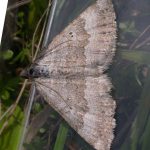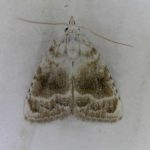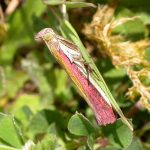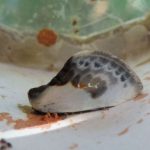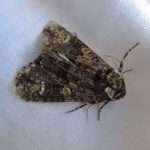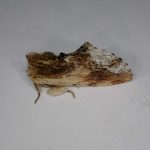Norman Hall organised the annual RDNHS mothing event, which this year was held at Boze Down, Whitchurch-on-Thames on the night of 30-31 July, with the kind permission of, and with great help from the owner, Sandra Parkinson, who lives in the house there called Chalkhills.
It was very successful: 183 species were recorded (33 micro-moths, 29 pyralid moths, 2 plume moths and 118 macro-moths).
Highlights among the macro-moths included The Mocha, Chalk Carpet (A British Action Plan (BAP) species, of which 72 were recorded), Kent Black Arches, Brown-veined Wainscot (unexpected) and Square-spotted Clay (another BAP species). For me, however, it was the pyralid-moths that impressed most. These included Mecyna flavalis (4), Nomophila noctuella (1), Rhodophaea formosa (1), Delplanqueia dilutella (1) and Oncocera semirubella (71). The total of 71 for semirubella was quite unexpected. One was caught on Greenham Common in 2009 (L.J.Finch) and they now occur frequently in Berks & Oxon but I had never seen more than 5 on any single occasion.
The site is a long curving valley above where there was once a Vineyard – with a new plantation on the S/SW side, and a wooded bank on the N/NE side (marked on the Defra Magic Map as ‘The Skippets’) which seems to be a boundary bank of a prehistoric fort, and may have provided a reservoir of fauna and flora for repopulation of the valley following farming activities. Five of us turned up with moth traps: myself, Jan Haseler, Paul Black, Ian Esland and Roy Dobson, so we were able to spread out across the whole of the valley, including both sides – and I was also invited to run a trap in the garden of Sandra’s neighbour. All the traps were run overnight.
On the Sunday morning about 20 members and visitors came to view the catch – but it also gave the trappers time to look at each other’s specimens as they had between them put examples of almost every species caught into 1” glass tubes, where they are easy to examine and pass around. This made it very easy for me to give a short talk putting the catch into perspective, and to select one group – the prominents – to make the point that it often the smaller ‘families’ of moths that are most interesting. The prominents include many spectacular-looking species with the very effective camouflage.
Report by Norman Hall
Pictures by Rob Stallard and Jan Haseler

